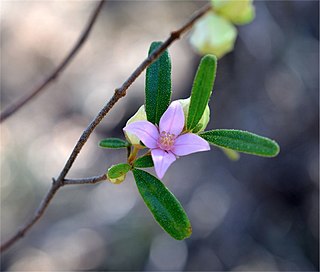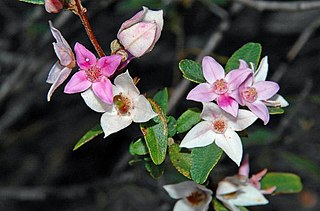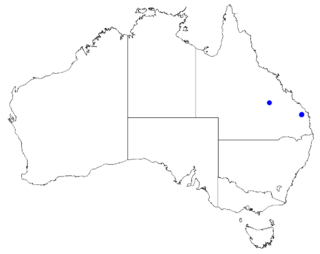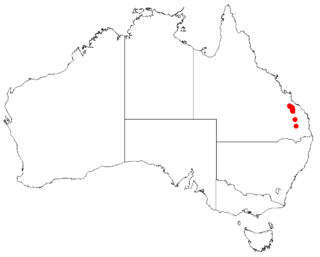
Zieria compacta is a plant in the citrus family Rutaceae and is endemic to eastern Australia. It is an erect, bushy shrub with leaves composed of three leaflets, and white flowers with four petals and four stamens. It usually grows in rocky places on steep hills.
Zieria actites is a plant in the citrus family Rutaceae and is only found on a single, isolated mountain in Queensland. It is a dense, compact shrub with wiry branches, three-part leaves and small, cream to pale pink flowers with four petals and four stamens.

Zieria fraseri is a plant in the citrus family Rutaceae and is endemic to eastern Australia. It is a dense, bushy shrub with leaves composed of three leaflets, and white flowers with four petals and four stamens. It usually grows in rocky places on steep hills.
Zieria graniticola is a plant in the citrus family Rutaceae and is a dense, compact shrub with erect wiry branches, three-part leaves and pale pink flowers in groups of up to three, each with four petals and four stamens. It is only known from two population near Stanthorpe in Queensland, Australia.
Zieria inexpectata is a plant in the citrus family Rutaceae and endemic to south-eastern Queensland. It is a small, compact shrub with erect, wiry branches, three-part leaves and groups of up to twelve white flowers, the groups longer than the leaves and the flowers with four petals and four stamens. It was unexpectedly discovered by the authors during a field trip and its discovery led to a paper describing the zierias of Queensland, including sixteen new species.

Boronia anethifolia, commonly known as narrow-leaved boronia, is a plant in the citrus family, Rutaceae and is endemic to eastern Australia. It is an erect shrub with four-angled branches, bipinnate leaves and white, sometimes pale pink, four-petalled flowers.

Boronia duiganiae is a plant in the citrus family Rutaceae and is endemic to mountain ranges in south-east Queensland, Australia. It is an erect shrub with many branches, leaves with one, three or five leaflets, and pink to white, four-petalled flowers.

Boronia glabra, commonly known as sandstone boronia, is a plant in the citrus family Rutaceae and is endemic to eastern Australia. It is an erect or weak shrub with many branches, mostly glabrous leaves with a slightly paler underside, and bright pink, four-petalled flowers arranged singly in leaf axils.

Boronia grimshawii is a plant in the citrus family Rutaceae and is endemic to mountain ranges in central Queensland, Australia. It is an erect shrub with many branches, simple leaves with a densely hairy, pale underside, and pink, four-petalled flowers.

Boronia odorata is a plant in the citrus family Rutaceae and is endemic to the central highlands of Queensland, Australia. It is an erect shrub with many branches, mostly simple leaves and pink to white, four-petalled flowers.

Boronia warrumbunglensis is a plant in the citrus family Rutaceae and is endemic to a small area in the central west of New South Wales. It is a shrub with many branches, pinnate leaves and one or two pink, four-petalled flowers in the leaf axils. It is only known from the Warrumbungles and nearby districts.

Boronia beeronensis is a plant in the citrus family Rutaceae and is endemic to the Beeron National Park in Queensland, Australia. It is an erect shrub with many hairy branches, narrow, simple leaves, and four-petalled flowers.

Boronia bella is a plant in the citrus family Rutaceae and is endemic to a mountain range near Many Peaks Queensland, Australia. It is an erect shrub with many branches, simple leaves and four-petalled flowers.
Boronia citrata, commonly known as lemon boronia, is a plant in the citrus family, Rutaceae and is endemic to Victoria. It is an erect, woody shrub with pinnate, strongly lemon-scented leaves and pale pink to rosy pink, four-petalled flowers arranged in groups of up to five.

Boronia excelsa is a plant in the citrus family Rutaceae and is endemic to a small area in Far North Queensland. It is an erect shrub with woolly-hairy branches, simple, stalkless, more or less hairless leaves, and pink to white, four-petalled flowers.

Boronia foetida is a plant in the citrus family Rutaceae and is endemic to a small area in Queensland. It is an erect shrub with hairy branches, simple leaves and pink to white, four-petalled flowers usually arranged singly in leaf axils. The leaves have an unpleasant smell when crushed.
Boronia hoipolloi is a plant in the citrus family Rutaceae and is endemic to a small area in Queensland. It is an erect or pendulous shrub with pinnate leaves and pink, four-petalled flowers. It is only known from a few collections near Mount Isa.

Boronia jensziae, commonly known as Andy Jensz's boronia or Hinchinbrook boronia, is a plant in the citrus family Rutaceae and is endemic to Hinchinbrook Island in Queensland. It is an erect, densely branched shrub with simple leaves and pink to white, four-petalled flowers usually arranged singly in leaf axils.

Boronia palasepala is a plant in the citrus family Rutaceae and is endemic to a small part of Queensland, Australia. It is an erect, rounded shrub with many branches, simple leaves and pink to white, four-petalled flowers.

Boronia parviflora, commonly known as the swamp boronia, small boronia, tiny boronia, or small-flowered boronia, is a plant in the citrus family Rutaceae and is endemic south-eastern Australia. It is a weak, low shrub with elliptic to egg-shaped leaves with finely toothed edges and up to three pink, white or green four-petalled flowers arranged at or near the ends of the stems.
























